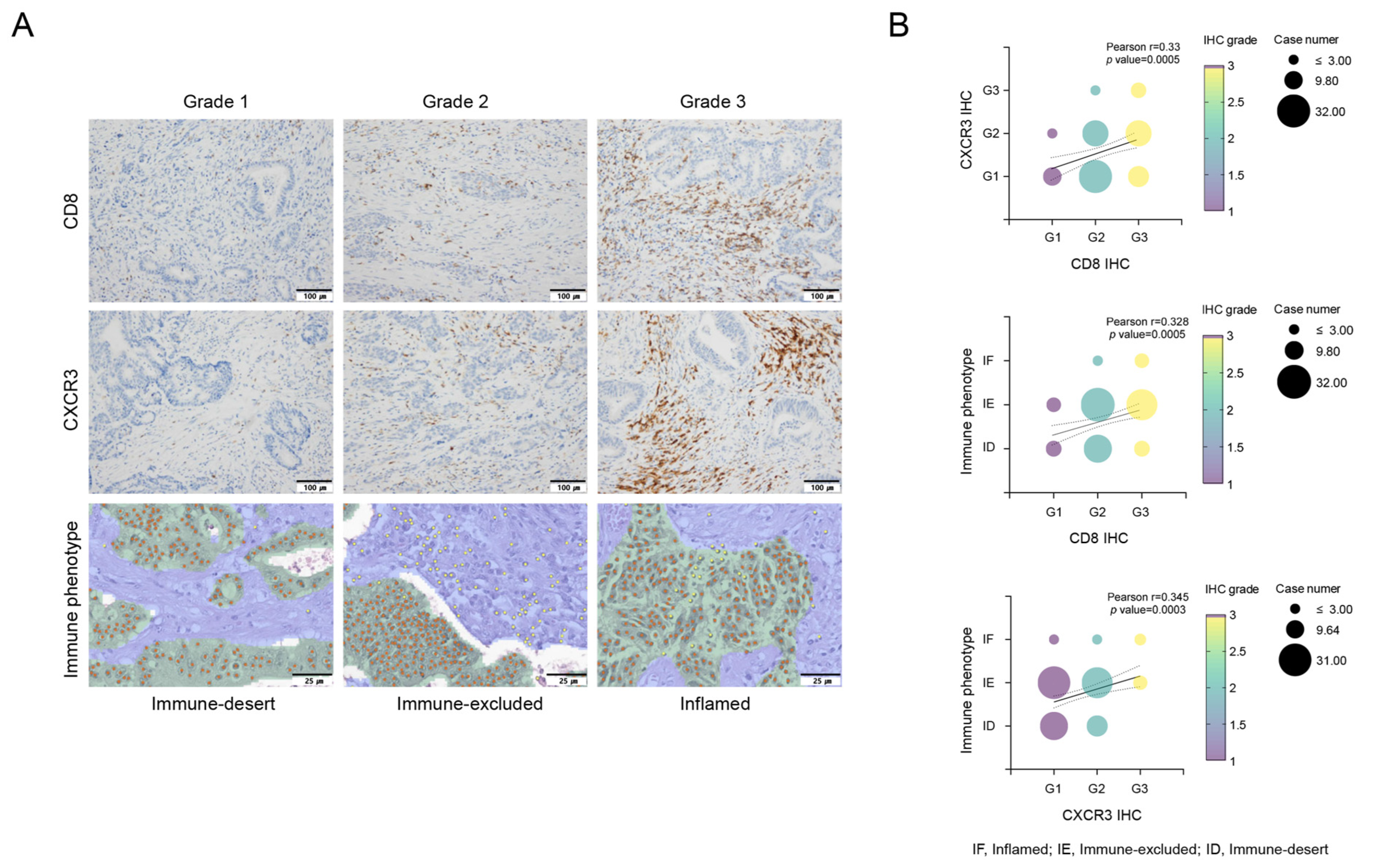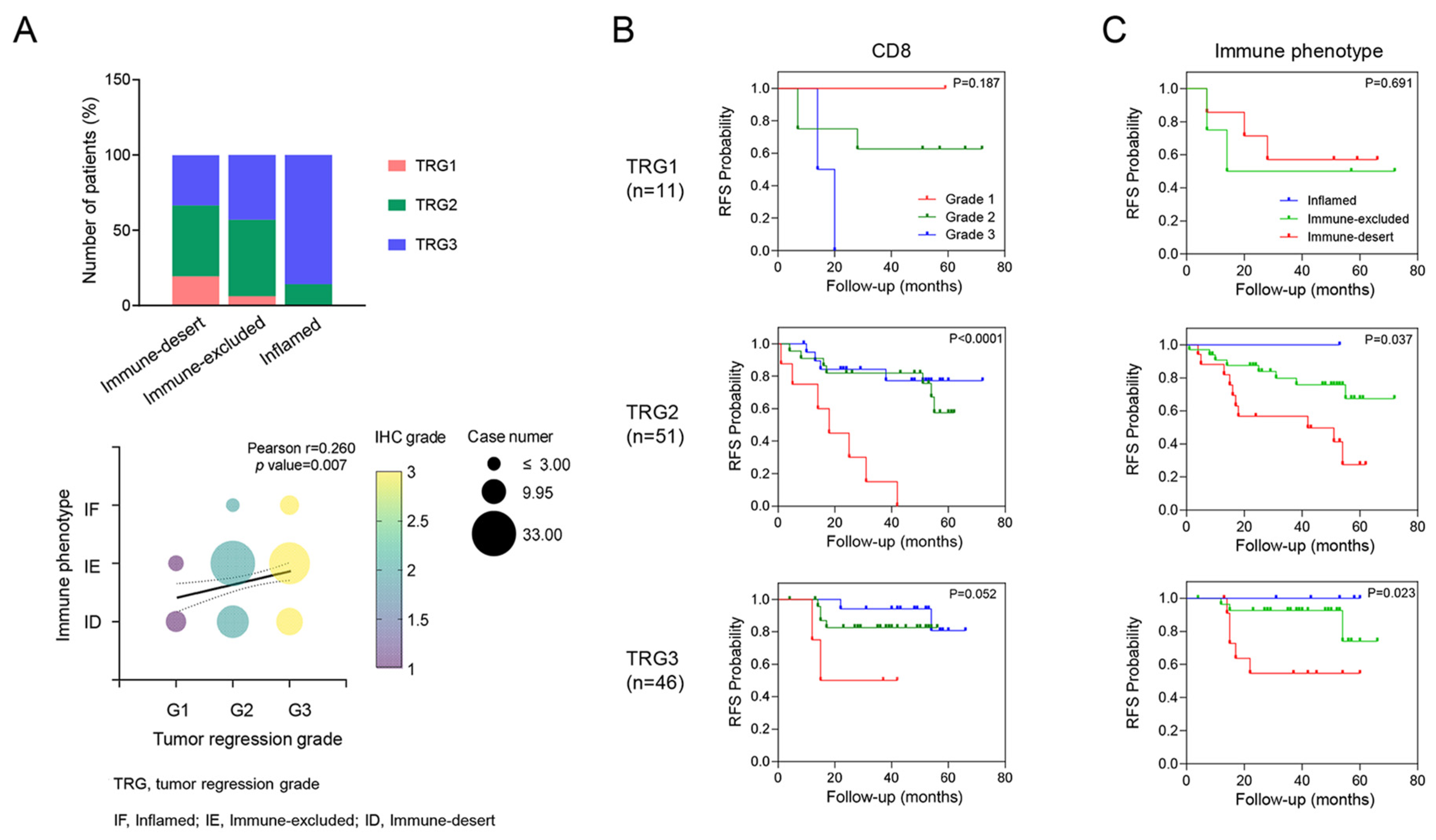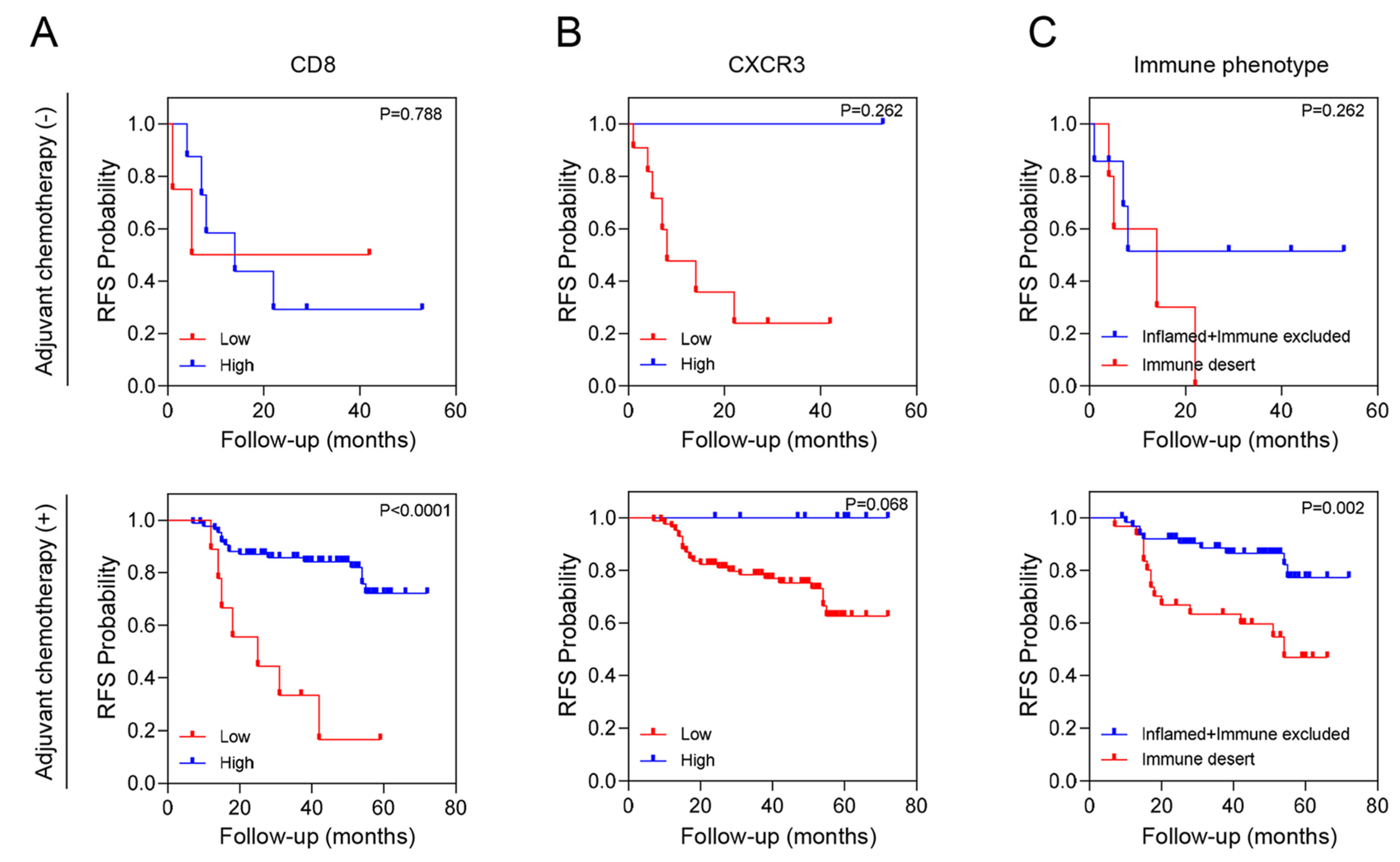Tumor Immune Microenvironment Biomarkers for Recurrence Prediction in Locally Advanced Rectal Cancer Patients after Neoadjuvant Chemoradiotherapy
Abstract
Simple Summary
Abstract
1. Introduction
2. Materials and Methods
2.1. Patients and Samples
2.2. Staging, Treatment, and Follow-Up
2.3. Pathologic Tumor Stage and Tumor Regression Grading
2.4. Immunohistochemical Staining
2.5. Neoadjuvant Rectal Score
2.6. Neutrophil-to-Lymphocyte Ratio
2.7. AI-Based Immune Phenotype Analysis
2.8. Statistical Analysis
3. Results
3.1. Patient Population, Clinical Characteristics and Survival Outcomes
3.2. Associations of the Clinicopathologic Parameters, TRG, NAR, and NLR, with Survival Outcomes
3.3. Immunohistochemical Staining for CD8+ T Cells and CXCR3 in TILs for Predicting RFS
3.4. Correlation of the Immune-Desert Immune Phenotype with CD8+ T Cells and CXCR3 in TILs
3.5. Univariate and Multivariate Analysis of Clinical Factors and the Tumor Immune Microenvironment According to Survival
4. Discussion
5. Conclusions
Supplementary Materials
Author Contributions
Funding
Institutional Review Board Statement
Informed Consent Statement
Data Availability Statement
Acknowledgments
Conflicts of Interest
References
- Sauer, R.; Becker, H.; Hohenberger, W.; Rodel, C.; Wittekind, C.; Fietkau, R.; Martus, P.; Tschmelitsch, J.; Hager, E.; Hess, C.F.; et al. Preoperative versus postoperative chemoradiotherapy for rectal cancer. N. Engl. J. Med. 2004, 351, 1731–1740. [Google Scholar] [CrossRef]
- Kalyan, A.; Rozelle, S.; Benson, A., III. Neoadjuvant treatment of rectal cancer: Where are we now? Gastroenterol. Rep. 2016, 4, 206–209. [Google Scholar] [CrossRef] [PubMed]
- Schrag, D.; Shi, Q.; Weiser, M.R.; Gollub, M.J.; Saltz, L.B.; Musher, B.L.; Goldberg, J.; Al Baghdadi, T.; Goodman, K.A.; McWilliams, R.R.; et al. Preoperative Treatment of Locally Advanced Rectal Cancer. N. Engl. J. Med. 2023, 389, 322–334. [Google Scholar] [CrossRef] [PubMed]
- Song, C.; Chung, J.-H.; Kang, S.-B.; Kim, D.-W.; Oh, H.-K.; Lee, H.S.; Kim, J.W.; Lee, K.-W.; Kim, J.H.; Kim, J.-S. Impact of Tumor Regression Grade as a Major Prognostic Factor in Locally Advanced Rectal Cancer after Neoadjuvant Chemoradiotherapy: A Proposal for a Modified Staging System. Cancers 2018, 10, 319. [Google Scholar] [CrossRef]
- Galon, J.; Costes, A.; Sanchez-Cabo, F.; Kirilovsky, A.; Mlecnik, B.; Lagorce-Pagès, C.; Tosolini, M.; Camus, M.; Berger, A.; Wind, P.; et al. Type, density, and location of immune cells within human colorectal tumors predict clinical outcome. Science 2006, 313, 1960–1964. [Google Scholar] [CrossRef] [PubMed]
- Park, I.J.; An, S.; Kim, S.-Y.; Lim, H.M.; Hong, S.-M.; Kim, M.-J.; Kim, Y.J.; Yu, C.S. Prediction of radio-responsiveness with immune-profiling in patients with rectal cancer. Oncotarget 2017, 8, 79793–79802. [Google Scholar] [CrossRef][Green Version]
- Luo, R.; Firat, E.; Gaedicke, S.; Guffart, E.; Watanabe, T.; Niedermann, G. Cisplatin Facilitates Radiation-Induced Abscopal Effects in Conjunction with PD-1 Checkpoint Blockade Through CXCR3/CXCL10-Mediated T-cell Recruitment. Clin. Cancer Res. 2019, 25, 7243–7255. [Google Scholar] [CrossRef]
- Kalluri, R. The biology and function of fibroblasts in cancer. Nat. Rev. Cancer 2016, 16, 582–598. [Google Scholar] [CrossRef]
- Chen, Y.; McAndrews, K.M.; Kalluri, R. Clinical and therapeutic relevance of cancer-associated fibroblasts. Nat. Rev. Clin. Oncol. 2021, 18, 792–804. [Google Scholar] [CrossRef]
- Kobayashi, H.; Gieniec, K.A.; Lannagan, T.R.; Wang, T.; Asai, N.; Mizutani, Y.; Iida, T.; Ando, R.; Thomas, E.M.; Sakai, A.; et al. The Origin and Contribution of Cancer-Associated Fibroblasts in Colorectal Carcinogenesis. Gastroenterology 2022, 162, 890–906. [Google Scholar] [CrossRef]
- Verset, L.; Tommelein, J.; Lopez, X.M.; Decaestecker, C.; Boterberg, T.; De Vlieghere, E.; Salmon, I.; Mareel, M.; Bracke, M.; De Wever, O.; et al. Impact of neoadjuvant therapy on cancer-associated fibroblasts in rectal cancer. Radiother. Oncol. 2015, 116, 449–454. [Google Scholar] [CrossRef] [PubMed]
- Orhan, A.; Khesrawi, F.; Madsen, M.T.; Vogelsang, R.P.; Dohrn, N.; Fiehn, A.-M.K.; Gögenur, I. Tumor-Infiltrating Lymphocytes as Biomarkers of Treatment Response and Long-Term Survival in Patients with Rectal Cancer: A Systematic Review and Meta-Analysis. Cancers 2022, 14, 636. [Google Scholar] [CrossRef] [PubMed]
- Kim, S.H.; Chang, H.J.; Kim, D.Y.; Park, J.W.; Baek, J.Y.; Kim, S.Y.; Park, S.C.; Oh, J.H.; Yu, A.; Nam, B.-H. What Is the Ideal Tumor Regression Grading System in Rectal Cancer Patients after Preoperative Chemoradiotherapy? Cancer Res. Treat. 2016, 48, 998–1009. [Google Scholar] [CrossRef] [PubMed]
- George, T.J., Jr.; Allegra, C.J.; Yothers, G. Neoadjuvant Rectal (NAR) Score: A New Surrogate Endpoint in Rectal Cancer Clinical Trials. Curr. Colorectal. Cancer Rep. 2015, 11, 275–280. [Google Scholar] [CrossRef] [PubMed]
- Fokas, E.; Fietkau, R.; Hartmann, A.; Hohenberger, W.; Grützmann, R.; Ghadimi, M.; Liersch, T.; Ströbel, P.; Grabenbauer, G.; Graeven, U.; et al. Neoadjuvant rectal score as individual-level surrogate for disease-free survival in rectal cancer in the CAO/ARO/AIO-04 randomized phase III trial. Ann. Oncol. 2018, 29, 1521–1527. [Google Scholar] [CrossRef]
- Walsh, S.; Cook, E.; Goulder, F.; Justin, T.; Keeling, N. Neutrophil-lymphocyte ratio as a prognostic factor in colorectal cancer. J. Surg. Oncol. 2005, 91, 181–184. [Google Scholar] [CrossRef]
- Kao, S.C.; Pavlakis, N.; Harvie, R.; Vardy, J.L.; Boyer, M.J.; van Zandwijk, N.; Clarke, S.J. High blood neutrophil-to-lymphocyte ratio is an indicator of poor prognosis in malignant mesothelioma patients undergoing systemic therapy. Clin. Cancer Res. 2010, 16, 5805–5813. [Google Scholar] [CrossRef] [PubMed]
- Petracci, E.; Passardi, A.; Biggeri, A.; Valgiusti, M.; Monti, M.; Frassineti, G.L.; Nanni, O.; Scarpi, E. Baseline and Longitudinal Neutrophil-to-Lymphocyte Ratio as Prognostic Factor for Metastatic Colorectal Cancer: A Secondary Analysis of the ITACa Randomized Trial. JCO Precis. Oncol. 2024, 8, e2300256. [Google Scholar] [CrossRef] [PubMed]
- Huang, A.; Xiao, Y.; Peng, C.; Liu, T.; Lin, Z.; Yang, Q.; Zhang, T.; Liu, J.; Ma, H. 53BP1 expression and immunoscore are associated with the efficacy of neoadjuvant chemoradiotherapy for rectal cancer. Strahlenther. Onkol. 2020, 196, 465–473. [Google Scholar] [CrossRef] [PubMed]
- Angell, H.K.; Bruni, D.; Barrett, J.C.; Herbst, R.; Galon, J. The Immunoscore: Colon Cancer and Beyond. Clin. Cancer Res. 2020, 26, 332–339. [Google Scholar] [CrossRef]
- Hong, Y.S.; Kim, S.Y.; Lee, J.S.; Nam, B.-H.; Kim, K.-P.; Kim, J.E.; Park, Y.S.; Park, J.O.; Baek, J.Y.; Lee, K.-W.; et al. Oxaliplatin-Based Adjuvant Chemotherapy for Rectal Cancer After Preoperative Chemoradiotherapy (ADORE): Long-Term Results of a Randomized Controlled Trial. J. Clin. Oncol. 2019, 37, 3111–3123. [Google Scholar] [CrossRef] [PubMed]
- Yoon, H.H.; Shi, Q.; Heying, E.N.; Muranyi, A.; Bredno, J.; Ough, F.; Djalilvand, A.; Clements, J.; Bowermaster, R.; Liu, W.-W. Intertumoral Heterogeneity of CD3(+) and CD8(+) T-Cell Densities in the Microenvironment of DNA Mismatch-Repair-Deficient Colon Cancers: Implications for Prognosis. Clin. Cancer Res. 2019, 25, 125–133. [Google Scholar] [CrossRef]
- Pagès, F.; Mlecnik, B.; Marliot, F.; Bindea, G.; Ou, F.-S.; Bifulco, C.; Lugli, A.; Zlobec, I.; Rau, T.T.; Berger, M.D.; et al. International validation of the consensus Immunoscore for the classification of colon cancer: A prognostic and accuracy study. Lancet 2018, 391, 2128–2139. [Google Scholar] [CrossRef] [PubMed]
- Argilés, G.; Tabernero, J.; Labianca, R.; Hochhauser, D.; Salazar, R.; Iveson, T.; Laurent-Puig, P.; Quirke, P.; Yoshino, T.; Taieb, J.; et al. Localised colon cancer: ESMO Clinical Practice Guidelines for diagnosis, treatment and follow-up. Ann. Oncol. 2020, 31, 1291–1305. [Google Scholar] [CrossRef]
- Sinicrope, F.A.; Shi, Q.; Catteau, A.; Poage, G.M.; Zemla, T.J.; Mlecnik, B.; Benson, A.B.; Gill, S.; Goldberg, R.M.; Kahlenberg, M.S.; et al. Immunoscore Is Prognostic in Low-Risk and High-Risk Stage III Colon Carcinomas Treated With Adjuvant Infusional Fluorouracil, Leucovorin, and Oxaliplatin in a Phase III Trial. JCO Precis. Oncol. 2022, 6, e2200010. [Google Scholar] [CrossRef] [PubMed]
- Nagarsheth, N.; Wicha, M.S.; Zou, W. Chemokines in the cancer microenvironment and their relevance in cancer immunotherapy. Nat. Rev. Immunol. 2017, 17, 559–572. [Google Scholar] [CrossRef] [PubMed]
- Mikucki, M.E.; Fisher, D.T.; Matsuzaki, J.; Skitzki, J.J.; Gaulin, N.B.; Muhitch, J.B.; Ku, A.W.; Frelinger, J.G.; Odunsi, K.; Gajewski, T.F.; et al. Non-redundant requirement for CXCR3 signalling during tumoricidal T-cell trafficking across tumour vascular checkpoints. Nat. Commun. 2015, 6, 7458. [Google Scholar] [CrossRef]
- Cheng, C.C.; Chang, J.; Ho, A.-S.; Sie, Z.-L.; Peng, C.-L.; Wang, C.-L.; Dev, K.; Chang, C.-C. Tumor-intrinsic IFNalpha and CXCL10 are critical for immunotherapeutic efficacy by recruiting and activating T lymphocytes in tumor microenvironment. Cancer Immunol. Immunother. 2024, 73, 175. [Google Scholar] [CrossRef]
- Wang, C.L.; Ho, A.-S.; Chang, C.-C.; Sie, Z.-L.; Peng, C.-L.; Chang, J.; Cheng, C.-C. Radiotherapy enhances CXCR3(high)CD8(+) T cell activation through inducing IFNgamma-mediated CXCL10 and ICAM-1 expression in lung cancer cells. Cancer Immunol. Immunother. 2023, 72, 1865–1880. [Google Scholar] [CrossRef]
- Gunderson, A.J.; Yamazaki, T.; McCarty, K.; Fox, N.; Phillips, M.; Alice, A.; Blair, T.; Whiteford, M.; O’Brien, D.; Ahmad, R.; et al. TGFbeta suppresses CD8(+) T cell expression of CXCR3 and tumor trafficking. Nat. Commun. 2020, 11, 1749. [Google Scholar] [CrossRef]
- Billottet, C.; Quemener, C.; Bikfalvi, A. CXCR3, a double-edged sword in tumor progression and angiogenesis. Biochim. Biophys. Acta 2013, 1836, 287–295. [Google Scholar] [CrossRef] [PubMed]
- Wang, X.; Zhang, Y.; Wang, S.; Ni, H.; Zhao, P.; Chen, G.; Xu, B.; Yuan, L. The role of CXCR3 and its ligands in cancer. Front. Oncol. 2022, 12, 1022688. [Google Scholar] [CrossRef] [PubMed]
- Yuan, Y. Modelling the spatial heterogeneity and molecular correlates of lymphocytic infiltration in triple-negative breast cancer. J. R. Soc. Interface 2015, 12, 20141153. [Google Scholar] [CrossRef] [PubMed]
- Corredor, G.; Wang, X.; Zhou, Y.; Lu, C.; Fu, P.; Syrigos, K.N.; Rimm, D.L.; Yang, M.; Romero, E.; Schalper, K.A.; et al. Spatial Architecture and Arrangement of Tumor-Infiltrating Lymphocytes for Predicting Likelihood of Recurrence in Early-Stage Non-Small Cell Lung Cancer. Clin. Cancer Res. 2019, 25, 1526–1534. [Google Scholar] [CrossRef] [PubMed]
- Saltz, J.; Gupta, R.; Hou, L.; Kurc, T.; Singh, P.; Nguyen, V.; Samaras, D.; Shroyer, K.R.; Zhao, T.; Batiste, R.; et al. Spatial Organization and Molecular Correlation of Tumor-Infiltrating Lymphocytes Using Deep Learning on Pathology Images. Cell Rep. 2018, 23, 181–193.e7. [Google Scholar] [CrossRef] [PubMed]
- Kasi, P.M.; Hidalgo, M.; Jafari, M.D.; Yeo, H.; Lowenfeld, L.; Khan, U.; Nguyen, A.T.H.; Siolas, D.; Swed, B.; Hyun, J.; et al. Neoadjuvant botensilimab plus balstilimab response pattern in locally advanced mismatch repair proficient colorectal cancer. Oncogene 2023, 42, 3252–3259. [Google Scholar] [CrossRef]




| Characteristics | N (%) |
|---|---|
| Sex | |
| Male | 79 (73.1) |
| Female | 29 (26.9) |
| Age | |
| Median (year) | 60 (36–90) |
| <70 | 69 |
| >70 | 39 |
| Tumor site | |
| upper-mid | 77 (71.2) |
| low | 31 (28.7) |
| Clinical stage at diagnosis | |
| T Stage | |
| T2–3 | 44 (61.1) |
| T4 | 42 (38.9) |
| N Stage | |
| N0–1 | 62 (57.4) |
| N2 | 46 (42.6) |
| Adjuvant chemotherapy | |
| None | 12 (11) |
| 5-FU monotherapy | 41 (38) |
| 5-FU + oxalipaltin | 55 (51) |
| RFS | OS | ||||||||
|---|---|---|---|---|---|---|---|---|---|
| Characteristics | N | Univariate Analysis | Multivariate Analysis | Univariate Analysis | Multivariate Analysis | ||||
| HR (95% CI) | p-Value | HR (95% CI) | p-Value | HR (95% CI) | p-Value | HR (95% CI) | p-Value | ||
| Sex | |||||||||
| Female | 29 | 1 | 1 | ||||||
| Male | 79 | 1.4 (0.7–3.0) | 0.347 | 1.7 (0.6–5.1) | 0.300 | ||||
| Age | |||||||||
| <70 | 39 | 1 | 1 | ||||||
| ≥70 | 69 | 1.4 (0.7–3.0) | 0.326 | 1.7 (0.6–4.6) | 0.321 | ||||
| Site | |||||||||
| Upper-mid | 77 | 1 | 1 | ||||||
| Low | 31 | 2.5 (1.2–5.0) | 0.010 | 2.4 (0.9–6.3) | 0.077 | ||||
| Tumor grade | |||||||||
| G 1–2 | 99 | 1 | 1 | ||||||
| G 3 | 9 | 4.3 (1.6–11.3) | 0.016 | 3.7 (1.3–11.0) | 0.016 | 4.4 (1.2–15.6) | 0.012 | ||
| ypT | |||||||||
| ypT 0–3 | 95 | 1 | 1 | ||||||
| ypT 4 | 13 | 2.4 (1.0–5.8) | 0.051 | 4.3 (1.5–12.4) | 0.003 | ||||
| ypN | |||||||||
| ypN 0–1 | 97 | 1 | 1 | ||||||
| ypN 2 | 11 | 2.4 (0.9–6.3) | 0.064 | 1.4 (0.3–6.0) | 0.681 | ||||
| LVI | |||||||||
| No | 86 | 1 | 1 | ||||||
| Yes | 17 | 2.2 (1.0–4.7) | 0.046 | 4.6 (1.6–13.3) | 0.002 | 4.8 (1.5–15.5) | 0.008 | ||
| PNI | |||||||||
| No | 61 | 1 | 1 | ||||||
| Yes | 47 | 5.9 (2.5–13.6) | <0.01 | 5.3 (2.2–13.1) | <0.01 | 22.6 (3.0–170.6) | <0.01 | 12.6 (1.6–98.8) | 0.016 |
| Tumor deposit | |||||||||
| No | 91 | 1 | 1 | ||||||
| Yes | 17 | 2.1 (1.0–4.6) | 0.050 | 4.2 (1.6–11.3) | 0.002 | ||||
| MSI | |||||||||
| N/A | 13 | ||||||||
| Yes | 92 | 1 | 1 | ||||||
| No | 3 | 1.2 (0.1–13.4) | 0.876 | 21.0 (0–732) | 0.249 | ||||
| CRM status | |||||||||
| >1 mm | 82 | 1 | 1 | ||||||
| ≤1 mm | 26 | 3.9 (2.0–8.0) | <0.01 | 3.1 (1.5–6.7) | 0.004 | 6.7 (2.4–18.2) | <0.01 | 3.9 (1.4–11.0) | 0.011 |
| mDworak TRG | |||||||||
| 1–2 | 62 | 1 | 1 | ||||||
| 3 | 46 | 2.2 (1.0–5.0) | 0.048 | 2.1 (0.7–6.4) | 0.088 | ||||
| NAR | |||||||||
| <16 | 55 | 1 | 1 | ||||||
| ≥16 | 33 | 1.8 (0.9–3.6) | 0.164 | 1.4 (0.5–3.7) | 0.512 | ||||
| NLR | |||||||||
| <6 | 88 | 1 | 1 | ||||||
| ≥6 | 20 | 2.4 (1.1–5.2) | 0.024 | 2.5 (0.9–7.2) | 0.080 | ||||
| Adjuvant chemotherapy | |||||||||
| Yes | 96 | 1 | 1 | ||||||
| No | 12 | 6.2 (2.6–14.7) | <0.01 | 5.1 (1.9–13.5) | 0.001 | 10.6 (3.4–33.2) | <0.01 | 6.9 (1.9–25.3) | 0.003 |
| CD8+ T cell | |||||||||
| High, 2+, 3+ | 95 | 1 | 1 | ||||||
| Low, 1+ | 13 | 4.7 (2.2–10.4) | <0.01 | 2.3 (1.0–5.0) | 0.046 | 2.4 (0.8–7.5) | 0.128 | ||
| CXCR3 | |||||||||
| High, 3+ | 10 | 1 | 1 | ||||||
| Low, 1+, 2+ | 98 | 27.6 (0.3–249.6) | 0.023 | 30.1 (0.7–233) | 0.081 | ||||
| CXCL10 | |||||||||
| High, 3+ | 22 | 1 | 1 | ||||||
| Low, 1+, 2+ | 86 | 1.1 (0.4–2.6) | 0.640 | 1.3 (0.6–2.7) | 0.473 | ||||
| α-SMA | |||||||||
| High 2+, 3+ | 74 | 1.8 (0.8–4.2) | 0.055 | 1.2 (0.4–3.5) | |||||
| Low 1+ | 34 | 1 | 1 | 0.349 | |||||
| AI-immune phenotype | |||||||||
| Inflamed/Immune-excluded | 72 | 1 | 1 | ||||||
| Immune-desert | 36 | 3.3 (1.6–6.8) | <0.01 | 2.7 (1.3–5.7) | 0.010 | 4.3 (1.5–12.3) | 0.004 | ||
Disclaimer/Publisher’s Note: The statements, opinions and data contained in all publications are solely those of the individual author(s) and contributor(s) and not of MDPI and/or the editor(s). MDPI and/or the editor(s) disclaim responsibility for any injury to people or property resulting from any ideas, methods, instructions or products referred to in the content. |
© 2024 by the authors. Licensee MDPI, Basel, Switzerland. This article is an open access article distributed under the terms and conditions of the Creative Commons Attribution (CC BY) license (https://creativecommons.org/licenses/by/4.0/).
Share and Cite
Hwang, J.-E.; Kim, S.-S.; Bang, H.-J.; Kim, H.-J.; Shim, H.-J.; Bae, W.-K.; Chung, I.-J.; Sun, E.-G.; Lee, T.; Ock, C.-Y.; et al. Tumor Immune Microenvironment Biomarkers for Recurrence Prediction in Locally Advanced Rectal Cancer Patients after Neoadjuvant Chemoradiotherapy. Cancers 2024, 16, 3353. https://doi.org/10.3390/cancers16193353
Hwang J-E, Kim S-S, Bang H-J, Kim H-J, Shim H-J, Bae W-K, Chung I-J, Sun E-G, Lee T, Ock C-Y, et al. Tumor Immune Microenvironment Biomarkers for Recurrence Prediction in Locally Advanced Rectal Cancer Patients after Neoadjuvant Chemoradiotherapy. Cancers. 2024; 16(19):3353. https://doi.org/10.3390/cancers16193353
Chicago/Turabian StyleHwang, Jun-Eul, Sung-Sun Kim, Hyun-Jin Bang, Hyeon-Jong Kim, Hyun-Jeong Shim, Woo-Kyun Bae, Ik-Joo Chung, Eun-Gene Sun, Taebum Lee, Chan-Young Ock, and et al. 2024. "Tumor Immune Microenvironment Biomarkers for Recurrence Prediction in Locally Advanced Rectal Cancer Patients after Neoadjuvant Chemoradiotherapy" Cancers 16, no. 19: 3353. https://doi.org/10.3390/cancers16193353
APA StyleHwang, J.-E., Kim, S.-S., Bang, H.-J., Kim, H.-J., Shim, H.-J., Bae, W.-K., Chung, I.-J., Sun, E.-G., Lee, T., Ock, C.-Y., Nam, J.-S., & Cho, S.-H. (2024). Tumor Immune Microenvironment Biomarkers for Recurrence Prediction in Locally Advanced Rectal Cancer Patients after Neoadjuvant Chemoradiotherapy. Cancers, 16(19), 3353. https://doi.org/10.3390/cancers16193353








